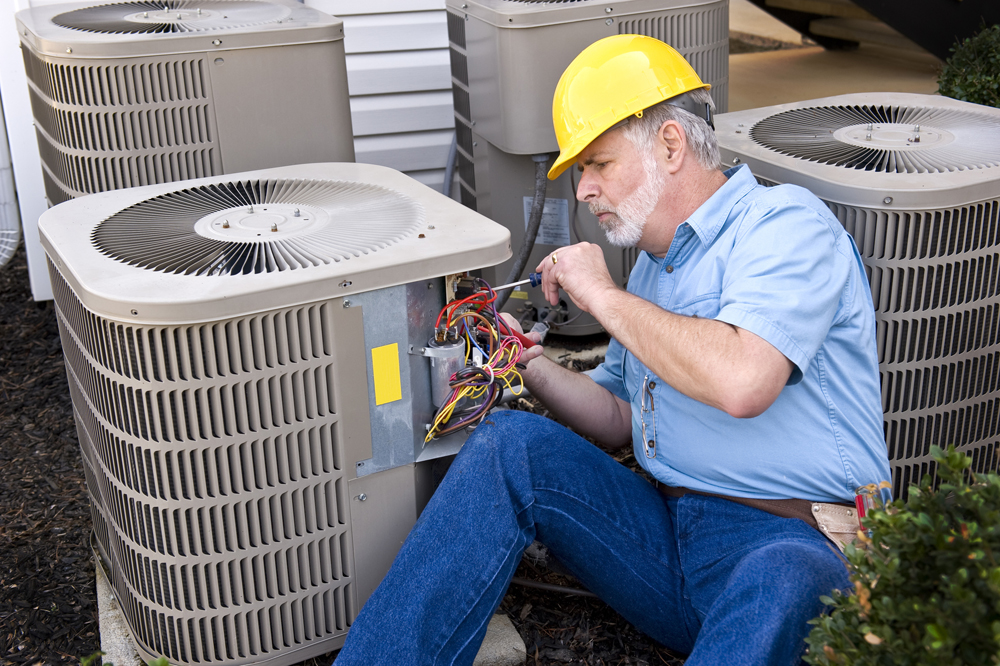Air Conditioning Installation in High-Rise Buildings: Unique Challenges

A/c Services: Typical Issues in High-Rise Buildings
If you've ever before experienced a situation where the cooling in your skyscraper appeared to be blowing warm air despite the thermostat being set to cool down, you might be knowledgeable about one of the typical problems faced in such structures.
Nevertheless, this issue is simply the idea of the iceberg when it pertains to the complexities of cooling fixings in high structures. Understanding the elaborate interplay between various elements affecting a/c systems in high-rises is crucial for efficient repairing and maintenance.
Trick Takeaways
- Weak airflow in high-rises suggests ductwork style concerns.
- Thermostat calibration is vital for exact temperature level control.
- Refrigerant leakages influence effectiveness and require prompt sealing.
- Correct upkeep of condensate drainage prevents obstructions in tall buildings.
Insufficient Air flow
If you discover weak airflow in your skyscraper, maybe an indication of underlying issues with the air conditioning system. Usual root causes of inadequate air flow often stem from airflow restrictions within the ductwork style. These constraints can happen due to various reasons such as blockages, incorrect sizing of ducts, and even bends and turns in the ductwork that restrain the smooth flow of air.
One of the main variables adding to air flow restrictions is the style of the ductwork. Improperly designed duct systems can cause irregular circulation of air throughout the building, causing certain areas obtaining not enough cooling or home heating. https://barkinghvac.co.uk/air-conditioning-repair.html Additionally, insufficient insulation or leaking ducts can better worsen air flow problems, triggering power wastefulness and pain for residents.
To deal with air movement problems properly, it's important to have the ductwork checked by an expert cooling and heating service technician. They can recognize any type of limitations, leaks, or design defects and advise ideal services to maximize air movement and enhance the total efficiency of the cooling system in your skyscraper.
Thermostat Malfunctions
When experiencing thermostat breakdowns in high-rise buildings, specialist intervention is essential to guarantee the functionality of the air conditioning system. Defective circuitry can lead to imprecise temperature level analyses, creating inconsistent temperature levels throughout the structure. Sensor calibration is important to assure that the thermostat properly shows the ambient temperature, protecting against unnecessary air conditioning or heating. https://barkinghvac.co.uk/air-conditioning-installation.html In addition, issues with sensor calibration can lead to the system running longer than needed, impacting power effectiveness.
To resolve thermostat breakdowns successfully, think about the following:
- Look for malfunctioning wiring that may be creating temperature level disparities.
- Frequently adjust sensing units to preserve exact temperature readings.
- Optimize thermostat setups for enhanced power performance.
- Make certain correct installation of the thermostat to stop breakdowns.
- Talk to HVAC professionals to detect and solve intricate thermostat concerns without delay.
Cooling agent Leaks
Attending to cooling agent leaks immediately is vital for preserving the effectiveness of your a/c system in high-rise buildings. Cooling agent plays an essential duty in the cooling procedure by absorbing and releasing warmth, however leakages can interrupt this cycle. When refrigerant leaks happen, the system's efficiency decreases, causing higher energy usage and lowered cooling capacity. Monitoring refrigerant stress is crucial to spotting leakages at an early stage. A drop in stress can show a leakage, motivating prompt repair services to stop further damage.
Leak detection methods such as using electronic leakage detectors or ultraviolet dye can aid pinpoint the source of the leakage. As soon as identified, the leak needs to be sealed immediately to avoid refrigerant loss and ensure the very best system efficiency. Normal maintenance checks can additionally help stop leakages by determining prospective weak points in the system before they end up being major concerns. By addressing cooling agent leakages immediately and implementing appropriate leakage discovery procedures, you can preserve the performance of your cooling system in skyscrapers and prevent pricey repair services down the line.
Unequal Air Conditioning Circulation

Maintaining constant air movement is vital for attaining even cooling distribution in skyscrapers. When irregular air conditioning takes place, specific areas may come to be uncomfortably cozy while others continue to be cold, causing tenant frustration.
To resolve this problem properly, consider the following:
- Thermostat Placement: Confirm thermostats are located far from warmth sources or chilly drafts to properly gauge the temperature level and control cooling.
- Stabilizing Dampers: Routinely check and adjust stabilizing dampers to control the amount of air flow to each area, promoting balanced cooling throughout the structure.
- Appropriate Insulation: Check insulation around ductwork to prevent air leak, maintaining the most effective temperature level control and reliable air circulation.
- Air Filter Maintenance: Clean or replace air filters frequently to stop clogs that can hinder air flow and hamper even cooling circulation.
- Heating And Cooling System Zoning: Use zoning systems to divide the structure right into different areas with private temperature level controls, ensuring each area obtains the suitable amount of air conditioning.
Condensate Drainage Issues
Consistently examine and clear condensate water drainage systems to prevent potential clogs and guarantee height working in high-rise buildings. Blocked pipes are an usual problem in cooling systems, especially in high-rise buildings where the condensate drain lines can run long distances. To avoid clogs, it's crucial to schedule regular maintenance checks.

Beginning by visually inspecting the drainage lines for any signs of obstructing or build-up. Furthermore, purge the lines with a combination of water and bleach to avoid algae and mold and mildew development, which can cause obstructions.
Maintenance pointers for condensate drainage systems consist of setting up a drainpipe frying pan therapy to avoid microbial development, frequently transforming air filters to maintain correct air movement, and making certain that the drainage lines have sufficient incline for water to stream easily.
If you see any type of indications of an obstructed condensate drainpipe, such as water leaks or lowered cooling performance, address the problem without delay to stay clear of more damage to the a/c system. By remaining proactive with maintenance, you can stop expensive fixings and guarantee effective operation of the a/c system in skyscrapers.
Regularly Asked Questions
Can Cooling Repair Works in High-Rise Buildings Be More Pricey Than in Single-Family Residences or Low-Rise Buildings?
Cooling repair work in skyscrapers can certainly be extra expensive contrasted to single-family homes or low-rise structures. The complexity of the systems and the trouble in accessing systems in tall frameworks can drive up the repair service costs.
To minimize these expenses, consider normal upkeep tips like altering filters often and scheduling professional assessments. Preventive care can assist identify issues early and avoid expensive repairs down the line.
Exactly How Can Residents in High-Rise Buildings Make Certain Appropriate Upkeep of Their Cooling Solutions to avoid Typical Problems?
To guarantee your cooling system in a skyscraper runs smoothly, comply with these maintenance pointers.
Maintain filters tidy to improve power efficiency and air high quality. Look for leaks regularly and schedule specialist assessments every year. Make use of a dehumidifier to control moisture degrees.
Are There Any Kind Of Specific Difficulties or Problems Connected With Fixing A/c Systems in Skyscraper Contrasted to Other Sorts Of Structures?
When fixing air conditioning systems in skyscrapers, there specify obstacles to take into account. Safety and security laws need to be strictly complied with to ensure the wellness of homeowners and employees.
Access challenges might develop as a result of the height of the building, making it harder to reach certain locations for upkeep.
Noise problems are additionally widespread as the noise from the system can travel quickly between floorings.
Keeping power effectiveness is crucial in these high structures to keep expenses down.
What Are Some Potential Long-Term Outcome of Neglecting Air Conditioning Services in a High-Rise Building?
If you overlook a/c repair work in a skyscraper, prospective dangers can consist of decreased energy effectiveness, causing higher utility costs.
Furthermore, poor upkeep can influence interior air quality, creating discomfort and health and wellness problems for owners.
It's important to resolve these issues promptly to ensure the appropriate performance of the system and keep a comfortable environment for every person in the building.
Are There Any Specific Laws or Structure Codes That Govern Cooling Services in Skyscraper That Citizens Should Understand?
When it concerns cooling repair work in high-rise buildings, homeowners need to be aware of particular laws and building ordinance. These guidelines control the maintenance of a/c systems, guaranteeing safety and security and efficiency.
Final thought

Generally, maintaining proper a/c in skyscrapers can be an obstacle as a result of common troubles like insufficient air movement, thermostat malfunctions, refrigerant leakages, unequal cooling distribution, and condensate drainage problems.
Regular upkeep and punctual repair services are critical to assure the convenience and safety and security of occupants. By dealing with these issues in a prompt way, structure proprietors can protect against costly fixings and safeguard a positive indoor environment for all locals.
